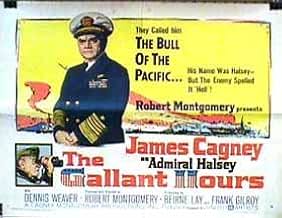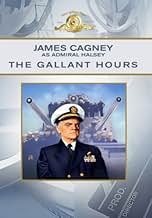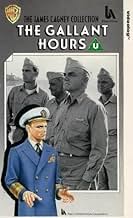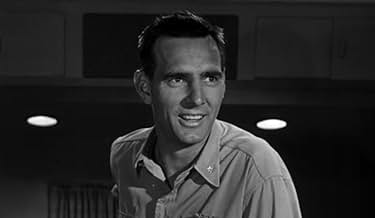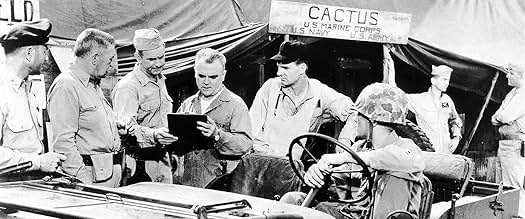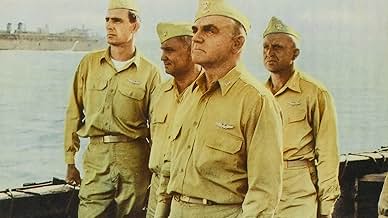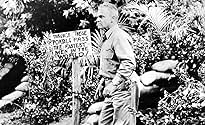CALIFICACIÓN DE IMDb
7.1/10
2.1 k
TU CALIFICACIÓN
El vicealmirante William F. Halsey comanda operaciones navales estadounidenses en el Pacífico Sur durante cinco semanas clave que conducen a la victoria aliada en Guadalcanal.El vicealmirante William F. Halsey comanda operaciones navales estadounidenses en el Pacífico Sur durante cinco semanas clave que conducen a la victoria aliada en Guadalcanal.El vicealmirante William F. Halsey comanda operaciones navales estadounidenses en el Pacífico Sur durante cinco semanas clave que conducen a la victoria aliada en Guadalcanal.
- Dirección
- Guionistas
- Elenco
- Dirección
- Guionistas
- Todo el elenco y el equipo
- Producción, taquilla y más en IMDbPro
Opiniones destacadas
Robert Montgomery directs this brief, but informative study of Adm. William F. 'Bull' Halsey Jr. in the Pacific during WWII. James Cagney is super as the highly decorated and revered Fleet Commander. Stoic, stern, confident and compassionate...Cagney in one of his best film performances.
Supporting cast is a mix of veteran actors and younger stars: Walter Sande, Les Tremayne, Dennis Weaver, Richard Jaeckel, James Yagi, Robert Burton and Ward Costello.
Supporting cast is a mix of veteran actors and younger stars: Walter Sande, Les Tremayne, Dennis Weaver, Richard Jaeckel, James Yagi, Robert Burton and Ward Costello.
10magneta
This is a surprisingly engaging war film, considering there are no action scenes. The movie is well-acted, although Dennis Weaver's "Chester" accent is a bit over-the-top. Cagney is superb as Admiral Halsey, in my opinion his best role ever. His understated pain in ordering only a 'routine' search for his missing son is beautiful, and the heart-to-heart with Roy Webb over the day's combat losses is a textbook lesson in the responsibilities of command. The use of the off-screen narrator in lieu of subtitles to present the Japanese side of the issue is tremendously effective; one wishes it had been used in other films as well. Although there are no combat scenes in the movie, the suspense is palpable as the command staff lives the battle through the air-to-air and ship-to-ship transmissions of men fighting for their lives.
For the war movie or history buff, or the die-hard Cagney fan, this is a fine movie!
For the war movie or history buff, or the die-hard Cagney fan, this is a fine movie!
This film is a leadership tutorial masterpiece. As a substitute high school math and science teacher, I have run this to conduct leadership laboratories. Additionally, the theme composition that opens the film is marvelous. I have tried to reconstruct the lyrics (had trouble understanding last verse lyrics) so that I could present the composition for adoption by the U. S. Naval Academy Mens' Chorus. Any help along these lines would be appreciated. I have attempted to locate survivors of Ward Costello, its composer, without success...for any necessary permission.
The most memorable scene is between Halsey (Cagney) and the candidate of air group commander (Richard Jaekel), when Jaekel says, "I thought I was alone." Cagney replies, "You were and you always will be."
The most memorable scene is between Halsey (Cagney) and the candidate of air group commander (Richard Jaekel), when Jaekel says, "I thought I was alone." Cagney replies, "You were and you always will be."
Straightforward black and white World War II battlefield biography about U.S. Navy Admiral William F. 'Bull' Halsey with zero combat scenes makes it a rough going 116 minutes despite an outstanding James Cagney as Halsey. Dennis "Chester" Weaverminus his limp from "Gunsmoke"--played his aide. Warning: if you watch this respectable war film, prepare yourself for a male chorus cooing behind the scenes in reverence. After the first 10 minutes, that cooing gets pretty thick. Director Robert Montgomery, who fought in World War II in the European Theater of Operations, reenacts everything in a semi-documentary style and adds to the film's overall sense of credibility. Nevertheless, this Hollywood epic ought to be a regular film on the History Channel because it doesn't deviate from the facts.
An unexpected *little* film from James Cagney. No snappy dancing, no slapping dames and bartenders around, no grapefruit saying hello to your face, no weird little body dance with the hitching up of pants, hunching the shoulders or snapping of fingers. No strutting or shooting locomotive engineers, no `Made it, Ma! Top of the World!.' Not even a glimpse of the old and much loved Warner Brothers logo for that matter.
In The Gallant Hours, Cagney, normally a smorgasbord of tics, sideways delights, raw energy, menace, and American good-guyism, does the least expected thing: he strips himself of all his familiar trademarks and instead delivers the most restrained, internalized, uncagneylike performance we've ever seen. Too bad it's a one-dimensional misrepresentation of the man he's playing---the crusty, bushy-eyed Fleet Admiral William F. *Bull* Halsey. But more about that in a minute.
Shot in black and white in semi-documentary style, The Gallant Hours is a low-budget, bare-bones, *cameo* production that doesn't attempt either the wide scope or the heroics of such better-known war films as Flying Fortress, Wake Island or Bataan. Instead, the film tightly focuses on the series of crucial, life-and-death decisions made by Admiral Halsey as he directs the desperate struggle in 1942 for possession of Guadalcanal, after it was discovered that the Japanese were building an airfield there from which they could launch attacks on Australia.
Produced and directed by actor and former naval officer Robert Montgomery, the film is a melange of the good, the bad, and the indifferent. The Gallant Hours has its moments, beginning auspiciously with a memorable opening scene of a lone sailor standing high up on a ship's mast, the camera then slowly panning down to reveal the rest of the ship's company massed on deck behind Halsey, who's crisply reading out his retirement orders. This is followed by a touching and well-done scene between him and his filipino valet, the two of them recalling the bloody, extended battle for Guadalcanal, which the film then turns to in extended flashback.
In place of battle action---there is none---the movie pads itself with several lightweight scenes that are either frivolous or yawn-inducing, such as when Halsey's aides, gathered on the beach, are oohing and ahhing over the ageing Admiral's prowess in the water, and, after Halsey has rejoined them, all of them then indulgently observing Dennis Weaver (as Halsey's chief pilot, Lt. Commander Andrew Jefferson 'Andy' Lowe) romping with a group of adoring navy nurses who are all agog over Dennis's tactical maneuvers.
The picture would have benefitted from scrapping fluff like this and sticking to the business of waging war, but no, the scriptwriters instead assume we require *entertainment*---the more mindless the better---in the form of multiple scenes of Dennis Weaver pursuing tail, or---the running gag for the first third of the film---Halsey finding ways of avoiding the innoculation shots that his medical officer wants to give him. Very jolly.
The production as a whole is intensely stylized and displays a palpable mood of mournfulness and regret over the horrific sacrifice of life among the Americans and their allies, who were desperately attempting to roll back the powerful Japanese advance in the South Pacific. This atmosphere is maintained throughout the film by the use of a soaring hymn-like musical score which suggests that the war at sea was virtually a holy war by the Allied Forces to save the world from the rampaging Axis powers.
Montgomery's direction is uneven and occasionally downright lazy, as when he several times settles for using the same boring establishing shot of Halsey's flagship sitting like a stilllife in port. Maybe, just once, he could have tried something else to establish the scene? And the sight of Dennis Weaver---one of my favorite actors---made to endlessly pursue more-than-willing navy nurses for comic relief shortly becomes tedious. Deprived of the opportunity to show battle action, the scriptwriters frequently appear to be vamping, for want of anything better to do.
For anyone who's seen John Ford's magnificent, eligiac 1945 wartime drama, They Were Expendable, in which Montgomery and John Wayne had starred, it will be obvious that the concept for The Gallant Hours was strongly influenced by the earlier film. Given the chance to direct, Montgomery apparently believed that what Ford could do, *he* could do better. But where Ford had sown his film with subtle tones of sadness, defeat, and loss, Montgomery drenches The Gallant Hours with painted-on emotion, conveyed primarily by its endlessly repeated score and a narrator who crisply and regularly informs you about which onscreen marine will be dead or badly injured in battle forty-five minutes later. They Were Expendable, now recognized as one of Ford's finest films, was effective without having to repeatedly cue its audience, while The Gallant Hours finds it necessary to frequently poke us when it's time to feel sad again or to grieve over incidents that are never depicted.
None of the above, however, is as off-kilter as the picture's biggest disappointment---its highly *edited* depiction of Halsey. The scriptwriters did an outrageous disservice to the public memory of Halsey by sanitizing the admiral into a nearly flawless, one-dimensional cardboard cutout---nearly a saint. He wasn't. According to his biographers, *Bull* Halsey was a salty, aggressive, Ulysses S. Grant-type warrior who liked his liquor---at one point he was receiving a monthly ration of seventeen cases of Scotch and six of bourbon, both for himself and for the purposes of entertaining others---and whose hatred of the Japanese was legendary and who exalted in killing them in large numbers, often allowing them to drown in the sea rather than picking them up and taking them prisoner. This was a man who was famous in naval circles for once erecting a large billboard that said, `Kill Japs! Kill Japs! Kill more Japs!' This wasn't a guy who, like his Japanese counterpart, Admiral Yamamoto, spent quality time arranging flowers to look just right for snapping with his Leica. Unsurprisingly, he was capable of exhibiting a ferocious temper if provoked and had other colorful human failings as well. The men who served with and under him loved and respected him in part for his being altogether human, for being one of them.
The Gallant Hours may get away with failing to show battle action, but it rolls over and dies when it fashions an utterly false picture of this great American wartime figure as a benign plaster saint who was followed by heavenly music wherever he went. Halsey's business was killing the enemy, not serving the Host to them during the Eucharist.
As for the film's lead, admittedly it is simply not possible to watch Jimmy Cagney and not enjoy him. The guy doesn't know how *not* to be interesting. But I would much rather have seen him play one of America's greatest naval warriors with all of that individual's various human qualities intact. It would have made for a much more compelling film.
In The Gallant Hours, Cagney, normally a smorgasbord of tics, sideways delights, raw energy, menace, and American good-guyism, does the least expected thing: he strips himself of all his familiar trademarks and instead delivers the most restrained, internalized, uncagneylike performance we've ever seen. Too bad it's a one-dimensional misrepresentation of the man he's playing---the crusty, bushy-eyed Fleet Admiral William F. *Bull* Halsey. But more about that in a minute.
Shot in black and white in semi-documentary style, The Gallant Hours is a low-budget, bare-bones, *cameo* production that doesn't attempt either the wide scope or the heroics of such better-known war films as Flying Fortress, Wake Island or Bataan. Instead, the film tightly focuses on the series of crucial, life-and-death decisions made by Admiral Halsey as he directs the desperate struggle in 1942 for possession of Guadalcanal, after it was discovered that the Japanese were building an airfield there from which they could launch attacks on Australia.
Produced and directed by actor and former naval officer Robert Montgomery, the film is a melange of the good, the bad, and the indifferent. The Gallant Hours has its moments, beginning auspiciously with a memorable opening scene of a lone sailor standing high up on a ship's mast, the camera then slowly panning down to reveal the rest of the ship's company massed on deck behind Halsey, who's crisply reading out his retirement orders. This is followed by a touching and well-done scene between him and his filipino valet, the two of them recalling the bloody, extended battle for Guadalcanal, which the film then turns to in extended flashback.
In place of battle action---there is none---the movie pads itself with several lightweight scenes that are either frivolous or yawn-inducing, such as when Halsey's aides, gathered on the beach, are oohing and ahhing over the ageing Admiral's prowess in the water, and, after Halsey has rejoined them, all of them then indulgently observing Dennis Weaver (as Halsey's chief pilot, Lt. Commander Andrew Jefferson 'Andy' Lowe) romping with a group of adoring navy nurses who are all agog over Dennis's tactical maneuvers.
The picture would have benefitted from scrapping fluff like this and sticking to the business of waging war, but no, the scriptwriters instead assume we require *entertainment*---the more mindless the better---in the form of multiple scenes of Dennis Weaver pursuing tail, or---the running gag for the first third of the film---Halsey finding ways of avoiding the innoculation shots that his medical officer wants to give him. Very jolly.
The production as a whole is intensely stylized and displays a palpable mood of mournfulness and regret over the horrific sacrifice of life among the Americans and their allies, who were desperately attempting to roll back the powerful Japanese advance in the South Pacific. This atmosphere is maintained throughout the film by the use of a soaring hymn-like musical score which suggests that the war at sea was virtually a holy war by the Allied Forces to save the world from the rampaging Axis powers.
Montgomery's direction is uneven and occasionally downright lazy, as when he several times settles for using the same boring establishing shot of Halsey's flagship sitting like a stilllife in port. Maybe, just once, he could have tried something else to establish the scene? And the sight of Dennis Weaver---one of my favorite actors---made to endlessly pursue more-than-willing navy nurses for comic relief shortly becomes tedious. Deprived of the opportunity to show battle action, the scriptwriters frequently appear to be vamping, for want of anything better to do.
For anyone who's seen John Ford's magnificent, eligiac 1945 wartime drama, They Were Expendable, in which Montgomery and John Wayne had starred, it will be obvious that the concept for The Gallant Hours was strongly influenced by the earlier film. Given the chance to direct, Montgomery apparently believed that what Ford could do, *he* could do better. But where Ford had sown his film with subtle tones of sadness, defeat, and loss, Montgomery drenches The Gallant Hours with painted-on emotion, conveyed primarily by its endlessly repeated score and a narrator who crisply and regularly informs you about which onscreen marine will be dead or badly injured in battle forty-five minutes later. They Were Expendable, now recognized as one of Ford's finest films, was effective without having to repeatedly cue its audience, while The Gallant Hours finds it necessary to frequently poke us when it's time to feel sad again or to grieve over incidents that are never depicted.
None of the above, however, is as off-kilter as the picture's biggest disappointment---its highly *edited* depiction of Halsey. The scriptwriters did an outrageous disservice to the public memory of Halsey by sanitizing the admiral into a nearly flawless, one-dimensional cardboard cutout---nearly a saint. He wasn't. According to his biographers, *Bull* Halsey was a salty, aggressive, Ulysses S. Grant-type warrior who liked his liquor---at one point he was receiving a monthly ration of seventeen cases of Scotch and six of bourbon, both for himself and for the purposes of entertaining others---and whose hatred of the Japanese was legendary and who exalted in killing them in large numbers, often allowing them to drown in the sea rather than picking them up and taking them prisoner. This was a man who was famous in naval circles for once erecting a large billboard that said, `Kill Japs! Kill Japs! Kill more Japs!' This wasn't a guy who, like his Japanese counterpart, Admiral Yamamoto, spent quality time arranging flowers to look just right for snapping with his Leica. Unsurprisingly, he was capable of exhibiting a ferocious temper if provoked and had other colorful human failings as well. The men who served with and under him loved and respected him in part for his being altogether human, for being one of them.
The Gallant Hours may get away with failing to show battle action, but it rolls over and dies when it fashions an utterly false picture of this great American wartime figure as a benign plaster saint who was followed by heavenly music wherever he went. Halsey's business was killing the enemy, not serving the Host to them during the Eucharist.
As for the film's lead, admittedly it is simply not possible to watch Jimmy Cagney and not enjoy him. The guy doesn't know how *not* to be interesting. But I would much rather have seen him play one of America's greatest naval warriors with all of that individual's various human qualities intact. It would have made for a much more compelling film.
¿Sabías que…?
- TriviaRear Admirals Scott and Callaghan were both killed in action in the naval battle of Guadalcanal. Admiral Halsey, who received a promotion, asked that his stars be given to the widows of the two men because, he said, their actions earned him that promotion. Halsey could not have known it at the time, but Admiral Scott was killed in a friendly fire incident aboard the USS Atlanta when it was accidentally fired upon by the USS San Francisco.
- ErroresAt the beginning of the move its stated that he retired on 22 November 1945. Halsey actually retired in March 1947.
- Citas
Fleet Admiral William F. 'Bull' Halsey Jr.: There are no great men, only great challenges that ordinary men are forced by circumstances to meet.
- ConexionesFeatured in War Movie Blockbusters (2015)
- Bandas sonorasThe Gallant Hours Theme
Words and Music by Ward Costello
Sung by Roger Wagner Chorale (as The Roger Wagner Chorale)
Selecciones populares
Inicia sesión para calificar y agrega a la lista de videos para obtener recomendaciones personalizadas
- How long is The Gallant Hours?Con tecnología de Alexa
Detalles
- Fecha de lanzamiento
- País de origen
- Idiomas
- También se conoce como
- The Gallant Hours
- Locaciones de filmación
- Marine Corps Base Camp Pendleton, California, Estados Unidos(used for Henderson Field and Gaudacanal)
- Productora
- Ver más créditos de la compañía en IMDbPro
- Tiempo de ejecución
- 1h 55min(115 min)
- Color
- Relación de aspecto
- 1.66 : 1
Contribuir a esta página
Sugiere una edición o agrega el contenido que falta


